Home | Class News | 50th Reunion | Past Reunions | Other Gatherings | Newsletter Archive | Links | Memorials | Classmates Search | Classmates Found | Former Faculty | Contacts |
![]()
Remembering Des McCracken
Ned Groth, September, 2014
(Author’s note: This remembrance is based on documents and personal communications, including yearbooks, class newsletters, letters Des wrote, conversations we had, and my own recollections. I have woven in anecdotes from other classmates, other alumni and former faculty. I’ve tried to create an honest and loving portrait of our former master, as we knew him. While I’ve striven for factual accuracy, I take full responsibility for any errors. This account can be amended, if need to be, as others contribute their own memories to it. –NG)
[Please note that the obituary for Des (from The Princeton Alumni Weekly) follows Ned's remembrance, below.]
 He was always “Des” or “Desi” (as in Arnaz—definitely a ‘50s reference) to us. Although he was christened James Desmond McCracken, I’d never heard anyone call him “James” until he was 80 and in an assisted-living facility, where the front-desk receptionist apparently was not on a first-name basis with him. Like other Darrow faculty in our era, Des intersected our lives in so many ways—teaching us (or trying to, in some cases) French, coaching the hockey teams, serving as the school librarian and leading the Library Crew at Hands-to-Work, house-mastering in Ann Lee and Valentine in our years, and after that, in Medicine Shop. Des was also often a drafted driver to ferry a sports team to an away meet, and for many years he volunteered in the Development Office, editing “Alumni Notes” for the Peg Board, maintaining and updating alumni and former faculty address records (which back then were typed on index cards), tracking down the lost and alienated among us. Were it not for his efforts, which continued even after he retired from teaching, far fewer of us might be connected with the school today (or reading this now).
He was always “Des” or “Desi” (as in Arnaz—definitely a ‘50s reference) to us. Although he was christened James Desmond McCracken, I’d never heard anyone call him “James” until he was 80 and in an assisted-living facility, where the front-desk receptionist apparently was not on a first-name basis with him. Like other Darrow faculty in our era, Des intersected our lives in so many ways—teaching us (or trying to, in some cases) French, coaching the hockey teams, serving as the school librarian and leading the Library Crew at Hands-to-Work, house-mastering in Ann Lee and Valentine in our years, and after that, in Medicine Shop. Des was also often a drafted driver to ferry a sports team to an away meet, and for many years he volunteered in the Development Office, editing “Alumni Notes” for the Peg Board, maintaining and updating alumni and former faculty address records (which back then were typed on index cards), tracking down the lost and alienated among us. Were it not for his efforts, which continued even after he retired from teaching, far fewer of us might be connected with the school today (or reading this now).
Des was a quiet, gentle, unassuming man, shy and socially awkward in some ways, but once you got to know him, you came to appreciate his considerable strengths. He had a sly sense of humor and a very quick wit. He loved puns (a love he shared with Lester Henderson among others), palindromes, crossword puzzles and quirky trivia. He kept track of birthdays and often sent friends and former students a list of famous events and famous people born on their birthdays. He was not demonstrative, but he was passionate about a few things—prominently, the French language, classical music (he probably had the best “hi-fi” system on campus in those days), and ice hockey—in particular NFL hockey, and fanatically, the Toronto Maple Leafs. When the Leafs were on the radio or TV, the boys in his dorms could count on hearing cheers and shouts through the walls or floorboards as the game unreeled.
In the classroom, Des was an authoritative, effective French teacher. Some of us marveled a bit at that. Here was this Scottish-American teacher, who admitted he had never set foot in France (though he’d been to Montreal!), but he really knew his stuff, and, as far as we could tell, spoke very clear, grammatically correct French, almost as if he were French. He had spent several summers at Middlebury College, taking courses and earning a master’s degree in teaching French. He used to tell us that he dreamed of going to Paris some day. And, as those of you who read our first Class of 1962 Newsletter in 1968—and have enough brain cells left now to remember it—will recall, he DID get to France (Des’s own caps, from his 1968 letter to me), and spent a month in Paris, in the summer of ’64. On the same trip, he went back to Scotland for the first time since he had left as a child.
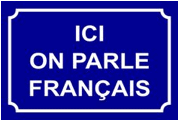 By the time we were in his classes, Des had been teaching at Darrow for four or five years, and he had no problems maintaining classroom decorum. He was not one of those teachers that kids tried to test or haze, perhaps because his own behavior was generally above reproach. He did slip now and then, though. I remember once in French III, our senior year. Des was at the blackboard, pacing back and forth, chalk in hand as he jotted things on the board, explaining something or other, when he suddenly wheeled and, with a baseball pitcher’s motion, fired the chalk almost straight at my head. The missile whizzed by my ear and struck Anson Perina, in the seat behind me, right on the noggin. Anson had apparently been dozing or staring into space, and Des had chosen this tactic to regain his attention. As I turned to see what the heck that was about, I saw a flash of anger in Grendel’s eyes and he tensed, as if about to leap out of his chair, but he quickly regained his composure, laughed and said something like, “Ha ha, Sir, nice shot.” And we went back to studying St. Exupery’s use of metaphor, or whatever.
By the time we were in his classes, Des had been teaching at Darrow for four or five years, and he had no problems maintaining classroom decorum. He was not one of those teachers that kids tried to test or haze, perhaps because his own behavior was generally above reproach. He did slip now and then, though. I remember once in French III, our senior year. Des was at the blackboard, pacing back and forth, chalk in hand as he jotted things on the board, explaining something or other, when he suddenly wheeled and, with a baseball pitcher’s motion, fired the chalk almost straight at my head. The missile whizzed by my ear and struck Anson Perina, in the seat behind me, right on the noggin. Anson had apparently been dozing or staring into space, and Des had chosen this tactic to regain his attention. As I turned to see what the heck that was about, I saw a flash of anger in Grendel’s eyes and he tensed, as if about to leap out of his chair, but he quickly regained his composure, laughed and said something like, “Ha ha, Sir, nice shot.” And we went back to studying St. Exupery’s use of metaphor, or whatever.
When I visited Des in 2012, at the facility in Lee, MA where he spent his final years, I brought up that chalk-throwing incident, and Des laughed, “I almost broke my hand,” explaining that in his follow-through, he had struck the edge of the teacher’s desk. Ah, the cost of impulse-control failures, and the many times we all relearn that lesson….
Carl Sharpe recalls a subtler form of discipline from Des. He explains “I was not the best French student, and in class I was always on the edge of getting in trouble.” Carl says Des had given him penalty hours for disruptive behavior, just once. Des kept a pad of pink slips (the medium for penalty hours) on his desk, and the moment that Carl’s behavior started to veer towards “shenanigans,” without saying a word, Des would look right at Carl and move his hand toward the pink slips, without interrupting the French lesson. Carl says it worked every time, and this unspoken communication went on between the two of them for a full academic year, during which Des never said a word (or needed to, apparently) to Carl about his comportment. Carl calls Des kind, gentle, good humored, and a hell of a nice guy, adding “For a kid who was pretty much out of control before Darrow, he was a perfect antidote.”
In Peter Gorday’s memories of French class, he sees Des “on a winter's day, pacing in front of the class in Wickersham, drilling us on some paradigm, correcting grammar, and offering a rare display of sartorial splendor in his predictable coat and tie and slacks and (as I recall) military boots. Under his tutelage there was something about conquering some obscure French colloquialism or convoluted verb-structure that gave real soul-satisfaction, so to speak. The universe looked more manageable after that.”
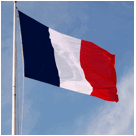 Peter remembers Des more broadly as “a deeply kind and tender man, funny at times and opaque at times, sometimes frustrating when people wanted more aggression from him, but without a touch of cruelty or sourness in his personality. He was a very methodical teacher of French, well attuned to detail, but always mindful of the bigger picture in the world of literature and ideas. He was a free-thinker in a world of dogmatists. As I look back on it, I think that when we read Camus with him, what we got was his liberal Scottish version of a French doctrinaire. Probably not a bad, if bizarre, combination.”
Peter remembers Des more broadly as “a deeply kind and tender man, funny at times and opaque at times, sometimes frustrating when people wanted more aggression from him, but without a touch of cruelty or sourness in his personality. He was a very methodical teacher of French, well attuned to detail, but always mindful of the bigger picture in the world of literature and ideas. He was a free-thinker in a world of dogmatists. As I look back on it, I think that when we read Camus with him, what we got was his liberal Scottish version of a French doctrinaire. Probably not a bad, if bizarre, combination.”
I remember one particular time in French class when Des (apparently spontaneously) made a bi-lingual pun and combined it with a moment of physical comedy. For whatever reason, he was teaching us the French term for a crow’s-nest, that tiny observation deck atop the mast of an old sailing ship. The French term is un nid de pie, (literally, crow’s nest), which when spoken sounds like “ah need a pee.” As he pronounced the French, Des crossed his legs, put his hands over his crotch and winced, just like a person whose bladder was about to burst. Sometimes Des, like Richard Bethards, let that quick wit and irreverence pop out in the open to liven up an occasionally boring classroom routine. The fact that I remember this French phrase and the moment I learned it, 55 years later, is a testament to his pedagogical skills.
 Unfortunately, it was rare for anyone to take photos for the Yearbook in classrooms in our day, so we have no shots of Des teaching. His role as hockey coach, however, is well documented. The team photo below is the 1960-61 varsity (this was the best of its genre in the yearbooks I have, even though someone wrote over part of it). Des began coaching hockey the first year he was at Darrow (’55-56); the school may not even have had a hockey team before he assumed that role. During our years, he coached the varsity and, when there were enough players for a second team, the JV as well. Coaching hockey was an onerous job. The school didn’t have its own rink. Once the weather got cold enough to freeze the ponds, Tanner’s or Joe Face’s Ponds were pressed into service for practice (after the snow was shoveled off!), using home-made (probably by Mike DiMaina) boards. But ponds weren’t adequate for games, so “home” contests, and a few practices, had to be on borrowed ice. That meant trips to nearby schools with rinks, often at awkward times to get some practice, and games played at far locales like RPI, Pittsfield or Lenox. If hardship builds character, the hockey teams surely built plenty of that—and from the many shared hardships, great camaraderie and team spirit. They also had some terrific athletes and talented players each year, had a lot of fun, and managed to win their share of games.
Unfortunately, it was rare for anyone to take photos for the Yearbook in classrooms in our day, so we have no shots of Des teaching. His role as hockey coach, however, is well documented. The team photo below is the 1960-61 varsity (this was the best of its genre in the yearbooks I have, even though someone wrote over part of it). Des began coaching hockey the first year he was at Darrow (’55-56); the school may not even have had a hockey team before he assumed that role. During our years, he coached the varsity and, when there were enough players for a second team, the JV as well. Coaching hockey was an onerous job. The school didn’t have its own rink. Once the weather got cold enough to freeze the ponds, Tanner’s or Joe Face’s Ponds were pressed into service for practice (after the snow was shoveled off!), using home-made (probably by Mike DiMaina) boards. But ponds weren’t adequate for games, so “home” contests, and a few practices, had to be on borrowed ice. That meant trips to nearby schools with rinks, often at awkward times to get some practice, and games played at far locales like RPI, Pittsfield or Lenox. If hardship builds character, the hockey teams surely built plenty of that—and from the many shared hardships, great camaraderie and team spirit. They also had some terrific athletes and talented players each year, had a lot of fun, and managed to win their share of games.
For a couple years in our era the school tried to build a seasonal rink on a flat area downhill from the chapel, flooding it once the weather turned frigid. Many of us remember players, and more often, Coach McCracken, standing out there with a hose on a freezing night, spraying the surface. It was all mostly in vain, although the ’61 yearbook reports that “For the first time in the history of the school, Darrow was host to a visiting hockey team.” (According to the yearbook, we lost to Barrington, 3-2.) Bob Lang says that was the only game ever played on that makeshift rink, correctly names Barrington as the opponent, but in his memory, we won. (I won’t attempt to resolve this conflict between contemporary written records and subjective memory 50 years later….maybe there was an unrecorded second game, a victory?)
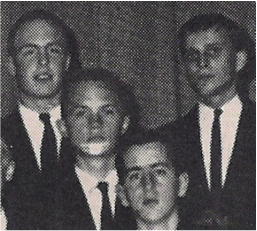 Hockey is a fast, violent, aggressive sport, and Des was pretty much the antithesis of that on all three counts. I’m not even sure he could skate. Nevertheless, he was by all accounts an excellent coach. He was an ardent hockey fan, and he understood the game—the techniques, strategies, nuances. He instilled that love for and appreciation of the game in many of his players. Some—like Stafford Keegin, Pete May, Bob Lang, R.J. Brandes—came to Darrow as accomplished hockey stars, but others learned the game from Des. Our sophomore year, I roomed with Peter Gorday, who surprised me at the end of soccer season by saying he was going out for the hockey team, as a goalie. It was a surprise because P.J. had not played hockey the year before, and the team already had an outstanding goalie—Keegin—who was a high-school All American lacrosse goalie and was at least as talented in the hockey net. But Peter liked the sport, liked Des, Des had encouraged him to try it, and he had an eye on the future—Keegin would graduate in 1960—so off he went to hockey practice. That very night, Peter came back to our room in Hinckley with a large bandage on his face—he’d stopped a puck with his chin. (The vignette here is cropped from the sophomore class photo in the 1960 yearbook—taken around that time.) As Peter now recalls the incident, it was his first day ever at hockey practice, a late autumn afternoon—football season was over, but of course there was no ice yet. Des had improvised a practice surface on the football field—a wooden surface upon which players (with no skates) could practice slap shots, a regulation goal some yards away for a target, and a goalie (with pads but no mask) in the net to get his own practice and challenge the shooters a bit. Pete recalls that the shot that hit him was low enough not to take out any teeth, but the wound required stitches. “Des drove me in to Pittsfield, then sat by and told hockey-stories while we waited for the sew-up,” Peter writes. “I have always remembered that occasion as one of gentle loving-care from a male mentor, when I was in a bad way. The implicit message that I took away was: ‘this kind of thing goes with the territory, but you (we) can handle it.’ Plenty of unspoken theology there.”
Hockey is a fast, violent, aggressive sport, and Des was pretty much the antithesis of that on all three counts. I’m not even sure he could skate. Nevertheless, he was by all accounts an excellent coach. He was an ardent hockey fan, and he understood the game—the techniques, strategies, nuances. He instilled that love for and appreciation of the game in many of his players. Some—like Stafford Keegin, Pete May, Bob Lang, R.J. Brandes—came to Darrow as accomplished hockey stars, but others learned the game from Des. Our sophomore year, I roomed with Peter Gorday, who surprised me at the end of soccer season by saying he was going out for the hockey team, as a goalie. It was a surprise because P.J. had not played hockey the year before, and the team already had an outstanding goalie—Keegin—who was a high-school All American lacrosse goalie and was at least as talented in the hockey net. But Peter liked the sport, liked Des, Des had encouraged him to try it, and he had an eye on the future—Keegin would graduate in 1960—so off he went to hockey practice. That very night, Peter came back to our room in Hinckley with a large bandage on his face—he’d stopped a puck with his chin. (The vignette here is cropped from the sophomore class photo in the 1960 yearbook—taken around that time.) As Peter now recalls the incident, it was his first day ever at hockey practice, a late autumn afternoon—football season was over, but of course there was no ice yet. Des had improvised a practice surface on the football field—a wooden surface upon which players (with no skates) could practice slap shots, a regulation goal some yards away for a target, and a goalie (with pads but no mask) in the net to get his own practice and challenge the shooters a bit. Pete recalls that the shot that hit him was low enough not to take out any teeth, but the wound required stitches. “Des drove me in to Pittsfield, then sat by and told hockey-stories while we waited for the sew-up,” Peter writes. “I have always remembered that occasion as one of gentle loving-care from a male mentor, when I was in a bad way. The implicit message that I took away was: ‘this kind of thing goes with the territory, but you (we) can handle it.’ Plenty of unspoken theology there.”
Llew Haden managed the hockey team in 1960-61 and ’61-62, and says Des was one of only two teachers (the other being Richard Bethards) that he, Llew, ever felt any connection to. (He adds that this reflected his own tendency to distance himself from people who genuinely wanted to help him, not any deficiencies in the other faculty.) Llew’s relationship with Des began in the classroom, where “given my negative aptitude for languages, including English, he tolerated my in-class performance and generously gave me C’s.” But Llew “really got to know and respect” Des as the hockey coach. He says “There were no ‘aha!’ moments but rather we found comfort in how we communicated and understood each other. Hard to describe.” Llew also fondly recalls the last time he saw Des. It was the night before our commencement and an event was under way in the Dairy Barn; Llew doesn’t remember what it was. But Des “motioned for me to follow him and we went out on the fire escape. He offered, and I accepted, a cigarette. We smoked and he wished me well in his quiet way. He was a good man.”
In that 1968 letter to me mentioned above, Des mused, in typically modest fashion, on his role, “…I’m more and more convinced that it isn’t coaching that matters. The important jobs include: producing pucks, white tape, black tape, new laces and dimes for ice cream machines at Pittsfield and RPI. Getting skates sharpened is another big chore. I’ve never been much of a coach. But I should be getting pretty good at playing manager, stick boy, trainer, driver, etc.”
 I also knew Des in non-class context; he was the head of my Hands-to-Work crew for a couple of years. In the fall of my freshman year, I believe at the fiat of Mr. Heyniger, I was taken from Dick Nunley’s crew, which was helping clear out the Dairy Barn in preparation for its renovation, and added to the Library crew, the 1958-59 version of which is shown here. Des also wore the school librarian’s hat, which put him in charge of our Wednesday afternoon labors, where he was a gentle and patient taskmaster. He may have spent a few minutes teaching me how to perform the tasks involved—or left most of that to Harry Savage and Jon van Vorst, the older kids on the crew. Quite honestly there was not much work involved—sweep the floors, empty the wastebaskets, dust the tables, straighten the chairs, and reshelve the books, not really enough to keep five boys busy for three hours every week. More challenging chores like replacing light bulbs atop the bookcases were left to the paid maintenance staff. Des would spend much of HTW time in the librarian’s office, by himself—cataloging various new acquisitions, perhaps—and leave us to our own devices. That had its advantages—we learned to work without supervision. Of course it also allowed Carl Braun to stuff me in the book-return cabinet one day when the opportunity presented itself (more impulse-control issues….)
I also knew Des in non-class context; he was the head of my Hands-to-Work crew for a couple of years. In the fall of my freshman year, I believe at the fiat of Mr. Heyniger, I was taken from Dick Nunley’s crew, which was helping clear out the Dairy Barn in preparation for its renovation, and added to the Library crew, the 1958-59 version of which is shown here. Des also wore the school librarian’s hat, which put him in charge of our Wednesday afternoon labors, where he was a gentle and patient taskmaster. He may have spent a few minutes teaching me how to perform the tasks involved—or left most of that to Harry Savage and Jon van Vorst, the older kids on the crew. Quite honestly there was not much work involved—sweep the floors, empty the wastebaskets, dust the tables, straighten the chairs, and reshelve the books, not really enough to keep five boys busy for three hours every week. More challenging chores like replacing light bulbs atop the bookcases were left to the paid maintenance staff. Des would spend much of HTW time in the librarian’s office, by himself—cataloging various new acquisitions, perhaps—and leave us to our own devices. That had its advantages—we learned to work without supervision. Of course it also allowed Carl Braun to stuff me in the book-return cabinet one day when the opportunity presented itself (more impulse-control issues….)

During our junior and senior years, Des was out building that hockey rink on HTW days and Marie Sutherland replaced him as librarian. Her management style was perhaps a little more hands-on than Des’s, but that didn’t make much difference in terms of the quality of our HTW experience. A few years later, after the Sutherlands had departed, Des resumed the librarian position, and I believe he organized the school’s collection, over a period of years, once it was moved into the newly built C. Lambert Heyniger Library in the Meeting House. He served in that capacity for three decades. I was on the Board of Trustees in the 1980s; my wife, Sharon, is a science writer, and publishers sent her promotional copies of hundreds of books each year, hoping for a mention in Newsweek. We gave most of them away, and I would cart a boxful of books up to school each time I went up for a Board meeting. I remember how joyful Des was to receive those donations, which he assured me had helped a great deal to strengthen the library’s once anemic science sections.
When the first wave of us arrived on campus in 1958, Des was the house master of Ann Lee Cottage. Larz and Marylou Anderson lived in Valentine Cottage, which was a freshman dorm (with one senior resident assistant). In the spring that year, Larz and Marylou had their first child, Fergie, and they needed a little more room, so over the summer of 1959, Des and the Andersons traded domiciles—he moved up to Valentine and they relocated to Ann Lee. Marylou remembers that moving day vividly: “Des had a piano, and it was transported up the hill on a flatbed truck. Des sat on the flatbed also—playing the piano the whole trip!”
 Dick Nunley recalls that Des also played the organ, after a fashion. As a boy, growing up around the Riverside Church, where his father was pastor (more on that later), Des was modestly pleased, as Dick put it, to have been a page turner for Vergil Fox, the church’s noted organist. As Dick described Des’s organ playing, it occurred “provided that no one was within hearing distance,” and the music had to be in E flat.
Dick Nunley recalls that Des also played the organ, after a fashion. As a boy, growing up around the Riverside Church, where his father was pastor (more on that later), Des was modestly pleased, as Dick put it, to have been a page turner for Vergil Fox, the church’s noted organist. As Dick described Des’s organ playing, it occurred “provided that no one was within hearing distance,” and the music had to be in E flat.
Several of Des’s faculty colleagues remarked on his ability to mentor students, a capacity that was expressed in a dorm-parent context, among others. Dick described Des as “years ahead of the experts in educational theory” in recognizing that children learn best when they are known individually by a mentor who takes an interest in them and shows them the way to learning. He says Des did just that with the ninth graders up in Medicine Shop (which, a few years after we left, became the small, all-freshman dorm, while Valentine became purely a faculty residence.) Dick says “They were a happy bunch of boys. Des kept himself in the background, but all who knew him experienced his quiet kindness.”
Don Sutherland also praised Des as a wonderful mentor. “Des was a great housemaster, especially for the young freshmen who were away from home for the first time and didn’t know which way to turn,” Don wrote. Several other colleagues recall Des’s hosting fellow “bachelor” faculty members for what passed, on our isolated campus, for social events. “On Friday nights, I often went to his apartment,” writes Horton Durfee, “where we each opened a can of beer and settled down next to the radio, to listen to the Friday night boxing match.” Don Beaver also recalls those gatherings to listen to or watch the Friday Night Fights, adding that sometimes Bill Goff was the host, up in Ann Lee, and observing that “Des was an enthusiastic participant.”
During our senior year, Carl Braun was the RA living in Des’s dorm with seven freshmen, and he offered a humorous account of why. Carl played hockey and was on the Library Committee, he liked Des a lot, and says that “Early in my junior year I realized that I really would like to return to Valentine Cottage as the senior ‘in charge’.” He thought it was impossible for him—“Desi only accepted senior French students who were at least a foot taller and weighed 100 pounds more” than Carl could claim at that point. But he began a lobbying campaign, “bugging Desi every time I saw him.” At the end of the year, Des signed Carl’s yearbook, “We shall see?”
Well, history reveals that Carl got the job, and (he claims, and Des is not here to contradict him) they had a fabulous year—“there wasn’t one penalty hour issued that year for anyone late to breakfast.” My brother David (’65) was one of Carl’s freshman charges (the others were Lloyd Klein/Zane, Barry Chapnick, Charlie Neumeister, Pete Munsell, Frank Feeley and Rick Norcross). David notes that all seven of them spent four years at Darrow and they all (were) graduated together in 1965, an impressive feat that had never been done before, and something Des was so pleased by that he took them all out to dinner at Les Pyrenees.
![Description: [Dario HiFi system]](Des_0clip_image018.gif) Of course there were lighter moments. Carl says “When the freshmen were all down at study hall, Des would crank up the stereo and blow the roof off of Valentine.” David recalls that “We often awoke to full orchestras marching through the house,” and heard “disrespectful terms cast at a television we could not watch that carried a Maple Leafs’ game.” David remembers that one of Des’s punishments for mild dorm misbehavior was to spill a box of dried beans on the common room floor and make the offender(s) pick them up. David says Des never figured out that when he dumped the beans on the rug, they were really easy to collect. Carl recounts a time when Des was disgusted with the pigpen state of the north room upstairs in Valentine (then the residence of Messrs. Feeley and Norcross), and having issued several ineffectual warnings, Des decided that sterner action was called for. With Carl’s help, they “emptied pretty much the entire contents of the room” from the fire escape onto the lawn below. Carl says that was “a very bold move for Desi” (but see above discussions of impulse control issues for this pair), and swears that “We never laughed so hard as when we watched the guys return.”
Of course there were lighter moments. Carl says “When the freshmen were all down at study hall, Des would crank up the stereo and blow the roof off of Valentine.” David recalls that “We often awoke to full orchestras marching through the house,” and heard “disrespectful terms cast at a television we could not watch that carried a Maple Leafs’ game.” David remembers that one of Des’s punishments for mild dorm misbehavior was to spill a box of dried beans on the common room floor and make the offender(s) pick them up. David says Des never figured out that when he dumped the beans on the rug, they were really easy to collect. Carl recounts a time when Des was disgusted with the pigpen state of the north room upstairs in Valentine (then the residence of Messrs. Feeley and Norcross), and having issued several ineffectual warnings, Des decided that sterner action was called for. With Carl’s help, they “emptied pretty much the entire contents of the room” from the fire escape onto the lawn below. Carl says that was “a very bold move for Desi” (but see above discussions of impulse control issues for this pair), and swears that “We never laughed so hard as when we watched the guys return.”
 In the category of “Now it can be told,” Carl reveals that Des had a table-top hockey game (like the prototype shown below) and that he and Des would play endless hours of fierce contests in Valentine, often between study hall and lights out. Carl would be the Montreal Canadians, and Des, of course, would be the Maple Leafs (“I was never permitted to so much as touch a Maple Leafs player.”) Carl recalls that Les Henderson and Bill Aiken were often there to cheer Desi on. Carl credits Lester with suggesting that their games be used to develop and test plays and tactics for the varsity to use. He reveals, “Until now, none of the team had any idea how Desi dreamed up our plays—not even Lang!” Carl claims he was an ace at table hockey, and that Des’s efforts were “always in vain.” When pressed a bit, Carl did admit that the masters always had a few drinks while the table hockey games progressed, a ritual in which Carl was not invited to partake, and he concedes that his dominance was aided by the fact that “even after just one drink, Des’s coordination was greatly impaired.”
In the category of “Now it can be told,” Carl reveals that Des had a table-top hockey game (like the prototype shown below) and that he and Des would play endless hours of fierce contests in Valentine, often between study hall and lights out. Carl would be the Montreal Canadians, and Des, of course, would be the Maple Leafs (“I was never permitted to so much as touch a Maple Leafs player.”) Carl recalls that Les Henderson and Bill Aiken were often there to cheer Desi on. Carl credits Lester with suggesting that their games be used to develop and test plays and tactics for the varsity to use. He reveals, “Until now, none of the team had any idea how Desi dreamed up our plays—not even Lang!” Carl claims he was an ace at table hockey, and that Des’s efforts were “always in vain.” When pressed a bit, Carl did admit that the masters always had a few drinks while the table hockey games progressed, a ritual in which Carl was not invited to partake, and he concedes that his dominance was aided by the fact that “even after just one drink, Des’s coordination was greatly impaired.”
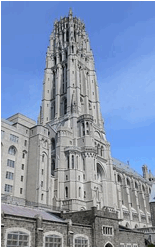 While our most vivid memories of Des come from the years when we lived on campus with him, of course his life began long before we met him and continued after we left Darrow. Des was born in Edinburgh on April 8, 1931, the elder son of the Reverend Robert James McCracken and Maud Ibbotson McCracken. His family moved to New York when he was a child, and in 1947 his father became pastor of the Riverside Church, in northern Manhattan. This well-known church was founded by John D. Rockefeller, and its first pastor was Harry Emerson Fosdick. Rev. James McCracken (he also went by his middle name), who spoke at Darrow at Commencement in 1961, was famous for his liberal theology. He preached that racism was a sin, and he said of atheists, "... we can learn from radical doubters ... It is the heretics who have forced the church to clear its mind, opened up to it new insights, spurred it on to deeper thinking about God and Christ and man ... Their concern is a challenge to our complacency."
While our most vivid memories of Des come from the years when we lived on campus with him, of course his life began long before we met him and continued after we left Darrow. Des was born in Edinburgh on April 8, 1931, the elder son of the Reverend Robert James McCracken and Maud Ibbotson McCracken. His family moved to New York when he was a child, and in 1947 his father became pastor of the Riverside Church, in northern Manhattan. This well-known church was founded by John D. Rockefeller, and its first pastor was Harry Emerson Fosdick. Rev. James McCracken (he also went by his middle name), who spoke at Darrow at Commencement in 1961, was famous for his liberal theology. He preached that racism was a sin, and he said of atheists, "... we can learn from radical doubters ... It is the heretics who have forced the church to clear its mind, opened up to it new insights, spurred it on to deeper thinking about God and Christ and man ... Their concern is a challenge to our complacency."
While his father was at Riverside, Des grew up in New York City. He graduated from Horace Mann School, in the Bronx, in 1949, and from Princeton in 1953. He then spent two years in the Army, finishing his service in 1955, at which point he joined the Darrow faculty.
Other than hearing his father preach that once, I knew very little about Des’s family, but in my last visit with him, in 2012, he told me something more about his parents. His mother, with whom he was quite close, died young, in her 50s, and his father was a widower for many years. Des’s father retired from Riverside Church in 1967, at the age of 63, “sooner than he had originally planned, because of failing health,” according to a contemporaneous account in the New York Times. Des told me that, late in life, his father remarried, and that he subsequently died, suddenly and unexpectedly, while on a cruise ship. According to the Times, Robert James McCracken died of an apparent heart attack, at the age of 68, at sea, near Bangkok, Thailand. Des admired his father a great deal—once when Peter Gorday visited Darrow, while he was at Dartmouth, he dropped in on Des on a Sunday evening and found him listening to his father’s sermon on the radio. He recalls the obvious pride with which Des told him, “That’s my dad.”
Des himself never married. He was a very private person, and lived essentially his entire adult life alone, as far as I know. He had a younger brother, (Richard) Norman—also known primarily by his middle name—who survives him, along with his wife, Eleanor, and Des’s nephews, Bruce and Scott (middle name Desmond), and several great-nephews and nieces.
For a number of years after we left Darrow, Des’s life went on much as it had when we were there. He became house master of the Medicine Shop when it was opened as a dorm in the la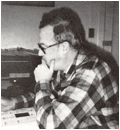 te 1960s. He kept on coaching hockey. He built and organized the library collection. He served as alumni secretary after Jack van Vorst, who had done it before him, retired (in 1969), and wrote the “Alumni Notes” section of the Peg Board. This photo, from the Peg Board in 1985, shows Des in journalist mode, composing a column.
te 1960s. He kept on coaching hockey. He built and organized the library collection. He served as alumni secretary after Jack van Vorst, who had done it before him, retired (in 1969), and wrote the “Alumni Notes” section of the Peg Board. This photo, from the Peg Board in 1985, shows Des in journalist mode, composing a column.
In 1968, I began writing the class newsletter, and Des sent me many good news-filled letters over the years. I also contacted him often, for addresses or word of some of our classmates and former teachers whom I hadn’t been able to reach. Des’s letters were very much from one friend to another—he was often willing to discuss things like the state of affairs on campus candidly, offering his incisive perceptions, regardless of the “official story.” Many things he told me were “off the record,” i.e., they never appeared in the newsletters. In 1976 Des became the longest-serving faculty member; he remarked to the Newsletter at that point that he was the only remaining link on campus who had known the Class of 1962 as students.
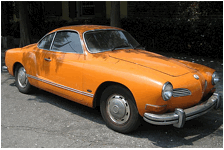 Des’s letters also included the usual mundane details, often prefaced by the words “I’m still…” As “I’m still an avid classical music fan…employ different kinds of radio to keep up with the world beyond New Lebanon.” In 1968, Des reported a modestly momentous event: he’d traded in his 1962 Karmann Ghia for a new VW squareback. As Des put it, the Ghia had been “suffering from old age (at 6 years?!) and lack of affection.” Don Sutherland remembers that Ghia (although he thought it was a BMW—right country, wrong company), which Des must have bought shortly after we left. Don said that Des’s previous car—some grey ghost of an early ‘50s American make—had fallen apart from rust and age, so Des bought a fancy, sporty German two-door sedan. It was orange and Don says they used to joke that Des could find it even in a Berkshires snow storm. But after a winter or two, Don wrote, the new car also began to rust badly—“so much for advanced Teutonic engineering,” and a testament to the rigors of New England Winters. “Like everything else,” Don wrote, “Des took this in stride, as if nothing about a Darrow winter could ever be surprising.” History does not record how long Des’s 1968 VW lasted….
Des’s letters also included the usual mundane details, often prefaced by the words “I’m still…” As “I’m still an avid classical music fan…employ different kinds of radio to keep up with the world beyond New Lebanon.” In 1968, Des reported a modestly momentous event: he’d traded in his 1962 Karmann Ghia for a new VW squareback. As Des put it, the Ghia had been “suffering from old age (at 6 years?!) and lack of affection.” Don Sutherland remembers that Ghia (although he thought it was a BMW—right country, wrong company), which Des must have bought shortly after we left. Don said that Des’s previous car—some grey ghost of an early ‘50s American make—had fallen apart from rust and age, so Des bought a fancy, sporty German two-door sedan. It was orange and Don says they used to joke that Des could find it even in a Berkshires snow storm. But after a winter or two, Don wrote, the new car also began to rust badly—“so much for advanced Teutonic engineering,” and a testament to the rigors of New England Winters. “Like everything else,” Don wrote, “Des took this in stride, as if nothing about a Darrow winter could ever be surprising.” History does not record how long Des’s 1968 VW lasted…. 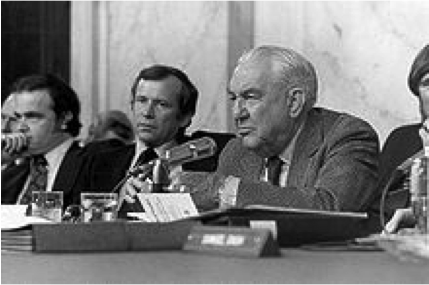
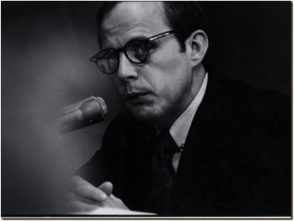 In 1975, writing to the Newsletter, Des reported that in 1973 he’d become fascinated with the unfolding Watergate saga (as many of us did then); he acknowledges that “from the early days…I had a suspicion, if not a conviction.” So he began taping news, commentary, speeches, Senate hearings—all facets of Watergate and Nixon. He called this “a great project” and admitted to “almost fanatically following daily developments.” The result, he said, was over 40 cassettes of material, “from Agnew to Sevareid, from Baker to Ziegler. And of course, last August 8th.” Des felt it had been worthwhile but added, “Don’t ask me what I’m going to do with it all, or when I could conceivably listen to it all. Maybe I’ll make a time capsule some day.” I can’t help but wonder whether a box with those 40 tapes is part of Des’s personal effects, and whether his heirs might give them to the Darrow library—what a wonderful gift from the French master to the History Department.
In 1975, writing to the Newsletter, Des reported that in 1973 he’d become fascinated with the unfolding Watergate saga (as many of us did then); he acknowledges that “from the early days…I had a suspicion, if not a conviction.” So he began taping news, commentary, speeches, Senate hearings—all facets of Watergate and Nixon. He called this “a great project” and admitted to “almost fanatically following daily developments.” The result, he said, was over 40 cassettes of material, “from Agnew to Sevareid, from Baker to Ziegler. And of course, last August 8th.” Des felt it had been worthwhile but added, “Don’t ask me what I’m going to do with it all, or when I could conceivably listen to it all. Maybe I’ll make a time capsule some day.” I can’t help but wonder whether a box with those 40 tapes is part of Des’s personal effects, and whether his heirs might give them to the Darrow library—what a wonderful gift from the French master to the History Department.
More than once, Des wrote, after listing happy events of the last year or two, “On the negative side, I’m still single.” I couldn’t tell, then or now, whether he really regretted being alone, or had grown accustomed, even resigned to that state but understood that society, more so back then perhaps than now, mildly disapproved of, or worse, made assumptions about, middle-aged bachelors, and was simply protecting himself against our possible misperceptions. He was such a shy, introverted man, but he generally seemed content to play the hand he’d been dealt.
Many of us recall that, during the years when Dave Miller was head, discontent grew among the alumni—over the deterioration of Shaker buildings, the widespread and relatively open presence of sex, drugs and rock ‘n’ roll on campus, the very liberal views of the administration, our impression that all the kids were hippies. When John Joline retired in 1975 and Dave was named to succeed him, Des wrote, “We are mighty happy about that.” Dave had the confidence of the faculty—he was “positive, efficient and understanding, relaxed and straightforward,” and he understood the needs of the students and faculty. But the next few years were turbulent, and eventually the changes the school went through began to wear on Des.
In a 1980 response for the class newsletter, Des thanked me for publishing some criticisms of campus developments. His big news was that he was no longer a house master; he had moved off campus, to a small apartment in East Chatham. His main reason for leaving was his feeling that “the kids were increasingly noisy, messy and insensitive.” He said that it had gotten too hard in the last couple of years for him to make the boys keep their rooms and the common areas of the dorm “reasonably tidy.” “I got mentally tired of fighting,” he said, and allowed as how perhaps he had some battle fatigue, after 24 years. But he felt that the younger faculty “don’t seem to notice” and the headmaster “doesn’t notice as much as he should.” Des added, “It’s not a simple matter; it takes all types,” but he sounded burned out. Like the rest of us, his age (and the era he was brought up in) were perhaps starting to show.
While he moved off campus, Des remained on the faculty until 1996, teaching French, keeping the library, and filling other roles described above. Hockey fell out of the athletic program in the ‘70s, when the school went co-ed; I think the smaller number of boys, added to the unrelenting difficulty of finding ice, pushed it over the edge. For 20 years, Des was the senior member of the faculty and the one person many returning alumni had been taught by. Those of us who attended Alumni Days (when they called it that) or our own reunions saw him at essentially every one, until 2010 or so. Here’s a montage of photos (mostly ones I took) of Des at various reunions, which also chronicle his (and our) graceful aging over the decades.
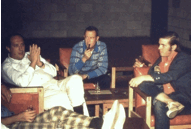
At our 10th reunion in 1972, Des smokes his pipe and listens as Ron Emery, Howdy Davis and Carl Sharpe (legs visible in foreground) converse.

When John and Jean Joline (at left here) retired in 1975, a group of us from their first senior class held a mini-reunion in late June to wish them “bon voyage,” and Des joined the celebration.
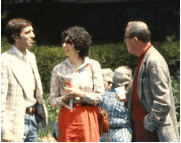
Here’s Des chatting with Van Selden ’60 and Van’s wife on alumni day, I think in 1980.
Maybe he didn’t attend or maybe he did but avoided my camera, but I don’t have any photos of Des at our 20th or 30th reunions. He was at our 25th (the Peg Board proves it) but I forgot to bring my camera to that one.
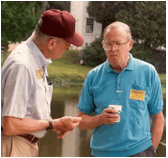

These two date from Alumni Days in 1994 (Des musing a point John Joline was making) and in 1997 (Des paying tribute to Charles Brodhead, who was honored with a ceremony during the alumni meeting in the Chapel.)

At our 40th reunion, we invited Des, Horton and Steve Swenson to join us for this class photo. Look closely and you’ll locate a partially obscured Des behind Denny Hopper.

Des was also in our class photo for our 45th, the last ‘62 reunion he attended (see below.) He joined us at our party that Friday at the Shaker Mill Inn. Here, he shares memories with Carl, Carl and Howdy.
Here are two I didn’t take. In midsummer of 2002, my brother David and his wife were en route to Vermont for a bicycling vacation. Sharon and I drove up and we all stayed for a couple of nights at the Shaker Mill Inn, and went over to see Des, meeting him on the campus. The other shot, from the Peg Board in 1989, shows Des sandwiched between Chris “Mad Dog” Russo ’77 and Coach Mahnken. The expression on Des’s face here is priceless, and along with the “What me worry?” shot of Des in his library office, it’s one of my favorites of him.

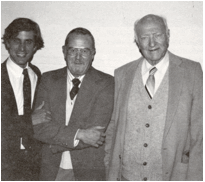
Leading up to our 45th reunion, in the fall of 2006, I was trying to track down some of our “lost” classmates, and called on Des for help. While he was supplying me with a few leads to the likes of “Pep” Peterson or John P. Spencer (both still lost, BTW), Des shared these facts about my birthday that he wagered “You probably won’t even find in Google”: On that date (September 28) in 1941, Laflin Whitehead Chapel at Darrow was dedicated; in 1972, the Shaker stone barn was gutted by fire; and in 2003, Audrey Dale Gallombardo, the school nurse before Aunt Coll and later the wife of Math teacher Anthony Gallombardo, passed away. Des remained a font of interesting (and sometimes even useful) information to the end.
By this time, of course, e-mail had replaced letters, and Des and I exchanged many brief notes. In early June 2011, I was planning to go up for the 50th reunion of the Class of 1961, and I sent Des an e-mail, hoping he could attend. He didn’t, and on July 4 he sent me an explanation. “I hit 80 in April,” he wrote, and the last few months “produced some troublesome medical matters.” He was using an oxygen mask at night, and some “ambulatory and balance problems popped up without warning” the week before reunions. He also said he was tiring easily now, and “Driving home after dark is another increasing challenge.” Noting the dearth of former faculty who had registered, and frankly worried about possibly embarrassing himself, Des had decided not to try to attend. He said he was “taking a pill to improve the balance problem” and hoped that would resolve, and “I’d like to join 1962 in 2012, but can’t promise.”
A few weeks later, Des was driving home from a doctor’s appointment and a woman who was driving behind him realized that he was in trouble. She followed him home and when she asked if he was OK, he was too disoriented to respond. She found his wallet, called Norman, and then called 911. Des was taken to Hudson Hospital, where he remained incoherent for some time; the diagnosis was a probable stroke. He gradually stabilized and began to regain physical and and mental functions, and around the end of August he was transferred to a rehab facility in Great Barrington. He remained there for the next four months, and later told me he hated it, but he improved, slowly but steadily, and in January of 2012 he moved into Laurel Lake Village, an “enhanced assisted living” facility in Lee, MA. 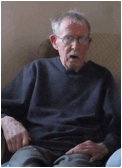
I visited Des at Laurel Lake that February 28, as it turns out, the last time I saw him. I found him physically frail but mentally pretty sharp. He was getting around the facility, using a walker. His speech was sometimes a little unclear but his memory seemed intact, and he recalled specific details about a lot of the members of our class (for example, re Gib Manchester, “Phone booth!”) He complained—he didn’t have his computer, couldn’t get any classical music stations on his radio, and the only hockey games he could tune in were from Boston—but he seemed himself and reasonably content. A longer report on that visit is posted on the Former Faculty News page.
That June, when we gathered for our 50th reunion, we had hoped that Des could get a day pass and come over to campus for part of the afternoon on Saturday, but he wasn’t up to it. Some of us did visit Des individually, at Laurel lake Village, later on. I think Carl Braun and Bob Lang made it up to Lee to see him at least once in the next year or so. (Carl confides that even then, “I had difficulty addressing him as Desi.”)
Over the past few months, Des’s condition deteriorated, and perhaps he had another stroke. He was back in the rehab center—and hating it. He developed pneumonia, and was taken to the hospital, where he rested comfortably for a day or so. He died, peacefully, with his brother and sister-in-law at his side, on September 8th.
When Lamb Heyniger hired this 24-year-old neophyte French teacher in 1955, he probably did not imagine that Des would remain at Darrow for his entire career, 41 years, teaching and guiding hundreds of students in so many ways. Several people who have shared their memories have made “Mr. Chips” allusions, and they do fit. Des devoted his life to Darrow and to the students he knew there. Au revoir, Desmond, and thank you for everything you taught us.





1956 1958 1960 1973 1979





1983 1988 1989 1994 1997


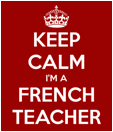
2002 2007
From The Princeton Alumni Weekly...
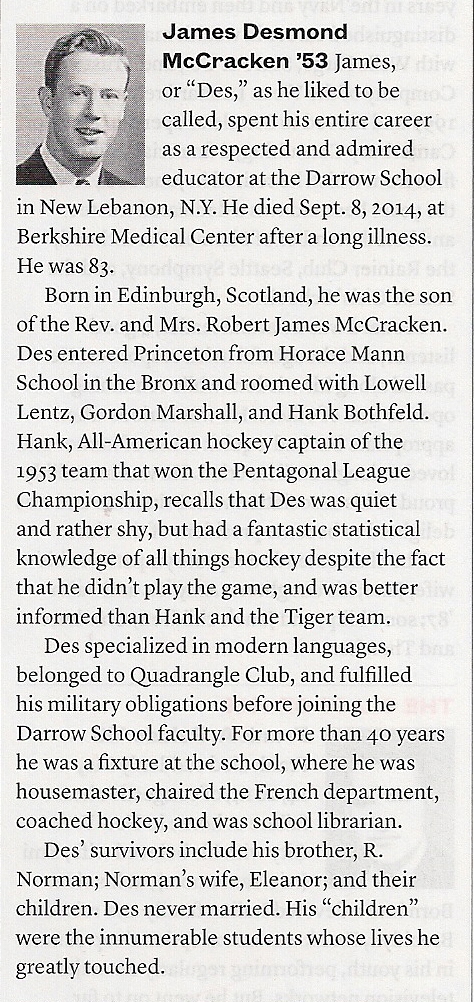
Home | Class News | 50th Reunion | Past Reunions | Other Gatherings | Newsletter Archive | Links | Memorials | Classmates Search | Classmates Found | Former Faculty | Contacts |